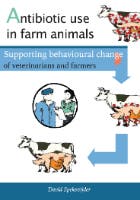David Speksnijder
Antibiotic use in farm animals. Supporting behavioural change of veterinarians and farmers.

- Datum
- (Co) promotoren
- 25-04-2017
- prof.dr. J.A. Wagenaar, prof.dr. Th.J.M. Verheij
Samenvatting
The use of antibiotics in animals selects for resistant bacteria with a (not-quantified) transfer of antimicrobial resistance from animals to humans. Therefore, restrictive use of antibiotics in animals is of utmost importance to protect public health. In this thesis, we identified factors that influence veterinarians’ choices to prescribe antibiotics and the possibilities for reduction of antibiotic use in farm animals. Veterinarians face conflicting interests in their position as antibiotic prescriber. The professional obligation to treat sick animals and a veterinarian’s perceived role as a service provider and problem solver for farmers might drive antibiotic prescribing. Also risk aversive behaviour plays an important role (fear of complications after non-prescribing). At the other hand, veterinarians reported to feel the pressure from the public and the government to use antibiotics restrictively. Also personal characteristics of veterinarians play a role. Older veterinarians for example seemed less convinced of a contribution of antibiotic use in animals to antimicrobial resistance in humans and expressed less hesitance to prescribe an antibiotic when in doubt of a diagnosis. Younger veterinarians expressed more concerns of possible negative side-effects on antimicrobial resistance but expressed higher levels of uncertainty to act independently from (perceived) farmers’ wishes. They might be more at risk to pander to risk aversive behaviour (i.e. prescribing antibiotics) to preserve a good relationship with a farmer. Veterinarians in our studies believed that antibiotic use on many farms can be lowered by increasing veterinary oversight and implementing proper management measures (e.g. improving feed quality, climate and housing conditions, vaccination schemes) to prevent diseases. These measures are however, not always implemented by farmers. Some farmers lack the motivation to reduce antibiotic use. Others may perceive the implementation of veterinary advices as too expensive or time consuming. Veterinarians should therefore be able to clearly explain the necessity and (cost) effectiveness of advised measures and tailor their advice to the specific context of a farmer. Tuning with other advisors might overcome the problem of conflicting advices, an often mentioned barrier for the uptake of veterinary advices. However, sometimes specific antibiotic use determinants as feed quality or immune status of young animals supplied by a breeder are beyond a farmers’ control. In a field trial, we have studied the effects of a structured and tuned collaboration between dairy farmers, veterinarians and feed advisors. These persons developed a structured animal health improvement program, tailored to the farm’s unique situation and under guidance of a professional facilitator with the aim to prevent animal diseases and lower antibiotic use. A good collaboration tended to have positive effects on animal health and seemed to enable a reduction in antibiotic use without adverse effects on animal health and productivity. Possibilities for a reduction in antibiotic use in farm animals can be found in proper communication channels and techniques to stimulate an intrinsic motivation of both veterinarians and farmers to reduce antibiotic use and in addressing enabling or limiting factors in the environment for the actual implementation of behaviour changes that will favour a reduction of antibiotic use.
